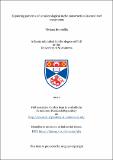Files in this item
Exploring patterns of coral ecological niche construction in coral reef ecosystems
Item metadata
| dc.contributor.advisor | Dornelas, Maria | |
| dc.contributor.author | Brambilla, Viviana | |
| dc.coverage.spatial | xiii, 142 p. | en_US |
| dc.date.accessioned | 2023-04-06T11:22:55Z | |
| dc.date.available | 2023-04-06T11:22:55Z | |
| dc.date.issued | 2021-11-30 | |
| dc.identifier.uri | https://hdl.handle.net/10023/27355 | |
| dc.description.abstract | Ecological niche construction is the process through which (i) organisms modify environmental states and (ii) their modifications favour the organisms’ fitness in return. Ecosystem engineers are an obvious class of putative niche constructors since they produce environmental change modulating resource flow within their ecosystems. Corals, a well-established group of autogenic ecosystem engineers, are a prime example of this class since through their own skeletal structures, they create the reef habitats they inhabit. This thesis aims at investigating coral ecological niche construction patterns in coral reef ecosystems. To understand how corals modify the reef environment (i), I show that reef quantitative surface descriptors that measure coral reef engineering affect patterns of light availability among reef habitats (chapter 2). Furthermore, I performed a coral reciprocal transplant experiment to assess to what extent coral could provide diverse habitats through plasticity. I detected that high plasticity in niche-constructing traits results in a higher ability to provide diverse habitats, under different environmental conditions (chapter 3). To understand if coral engineering activity was favourable to their own fitness (ii), I have studied patterns of coral recruitment across differently engineered habitats. I showed an increase in settler presence on artificial tiles deployed in the field along a gradient of coralbuilt structural complexity, measured as surface rugosity (chapter 4). I also showed an increase of juvenile abundance across reefs characterized by small-scale high fractal dimension and large-scale high surface rugosity, both being measures of coral engineering activity (chapter 5). With this thesis I aimed at clarifying the role of corals as ecological niche constructors, enabling a future description of coral niche construction as evolutionary agent. | en_US |
| dc.description.sponsorship | "This work was supported by a John Templeton Foundation grant (grant #60501 'Putting the Extended Evolutionary Synthesis to the Test’), a personal Ian Potter Doctoral Fellowships at Lizard Island Research Station (2018) and a personal MASTS small grant (grant SG396)." -- Funding | en |
| dc.language.iso | en | en_US |
| dc.publisher | University of St Andrews | |
| dc.relation | Coral recruitment patterns at Lizard Island (thesis data) Brambilla, V., University of St Andrews. https://doi.org/10.17630/79cda830-f3f9-4753-96f8-d3b489d1c844 | en |
| dc.relation.uri | https://doi.org/10.17630/79cda830-f3f9-4753-96f8-d3b489d1c844 | |
| dc.subject.lcc | QH541.5C7B8 | |
| dc.subject.lcsh | Coral reef ecology | en |
| dc.title | Exploring patterns of coral ecological niche construction in coral reef ecosystems | en_US |
| dc.type | Thesis | en_US |
| dc.contributor.sponsor | Templeton Foundation | en_US |
| dc.contributor.sponsor | Ian Potter Doctoral Fellowship | en_US |
| dc.contributor.sponsor | Marine Alliance for Science and Technology for Scotland (MASTS) | en_US |
| dc.type.qualificationlevel | Doctoral | en_US |
| dc.type.qualificationname | PhD Doctor of Philosophy | en_US |
| dc.publisher.institution | The University of St Andrews | en_US |
| dc.rights.embargoreason | Embargo period has ended, thesis made available in accordance with University regulations | en |
| dc.identifier.doi | https://doi.org/10.17630/sta/383 | |
| dc.identifier.grantnumber | 60501 | en_US |
| dc.identifier.grantnumber | SG396 | en_US |
This item appears in the following Collection(s)
Items in the St Andrews Research Repository are protected by copyright, with all rights reserved, unless otherwise indicated.

